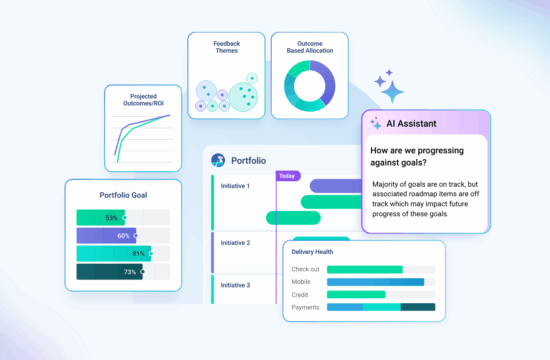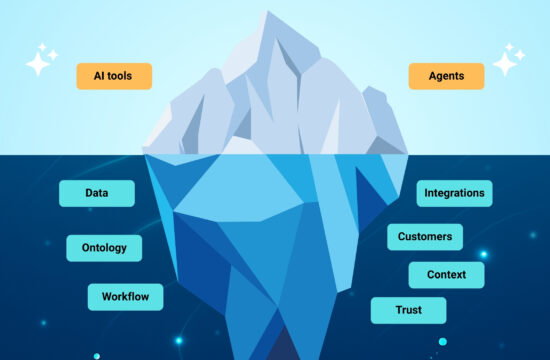In a hypercompetitive era, organizations must anticipate market shifts, allocate resources effectively, and deliver continuous customer and shareholder value to stay ahead. Agile Portfolio Management (APM) provides a strategic framework for aligning investments, resources, and business objectives, enabling enterprises to adapt quickly and thrive in the face of accelerating change.
This guide explores the principles, benefits, and best practices of Agile Portfolio Management and how senior product and operations leaders can leverage it to drive strategic alignment, optimize resource allocation, and achieve sustainable competitive advantage in complex product environments.
What is Agile Portfolio Management?
Agile Portfolio Management goes beyond the traditional, project-centric approach to portfolio management. While conventional approaches often rely on fixed plans and rigid, long-term roadmaps, APM embraces a flexible, iterative, and data-driven approach to decision-making based on real-time insights and market conditions.
Key Differences Between Traditional & Agile Portfolio Management
| Aspect | Traditional Portfolio Management | Agile Portfolio Management (APM) |
|---|---|---|
| Focus | Fixed, long-term project plans | Continuous, adaptive strategy |
| Decision-Making | Centralized, top-down | Decentralized, data-driven |
| Resource Allocation | Fixed budgets per project | Lean funding based on value streams |
| Change Response | Rigid processes | Dynamic, iterative approach |
Rather than committing to static roadmaps, APM enables leaders to continuously reassess priorities, reallocate investments, and respond to emerging opportunities in a rapidly evolving market.
To learn more about strategic planning across multiple product lines, read ‘How To Achieve Your Strategic Plan Across Your Product Portfolio’.
Key components of an Agile Portfolio include:
- Portfolio Vision: The articulation of the organization’s aspirational goals, serving as the strategic North Star that aligns all portfolio initiatives.
- Strategic Themes: High-level business priorities that shape the portfolio’s direction. These themes provide focus and alignment by ensuring that teams work toward specific, measurable, achievable, relevant, and time-bound (SMART) objectives.
- Value Streams: The end-to-end flow of value from idea to delivery, including all activities, teams, and stakeholders involved in creating and delivering value to customers.
- Epics (or Initiatives): Large-scale efforts that deliver significant business value, often requiring cross-functional collaboration, and are broken down into smaller deliverables within agile teams.
- Enablers: Strategic and foundational investments designed to enhance system capabilities, streamline architectural elements, and improve operational readiness, often focused on long-term competitive advantage. These include infrastructure improvements, technical debt reduction, security and compliance upgrades, and process automation.
- Lean Budgets: Unlike traditional fixed budgets, APM uses lean budgeting to allocate funds dynamically based on the strategic value, risk profile, market conditions, and potential return on investment (ROI) associated with individual initiatives.
For a deeper dive into the fundamental principles of Agile Portfolio Management, senior leaders can explore resources available through the Scaled Agile Framework (SAFe), a widely adopted methodology for scaling agility across the enterprise.
The Business Case for Agile Portfolio Management: Why It’s a Strategic Imperative
In an era characterized by disruptive technologies and increasingly volatile market dynamics, organizational agility is no longer a competitive advantage; it is an existential imperative. Agile Portfolio Management equips organizations with the capacity to swiftly respond to evolving customer needs, capitalize on emerging technological innovations, and proactively counter competitive threats. This is particularly critical within organizations managing complex product portfolios, where orchestrating multiple product lines and strategic initiatives can pose significant challenges.
By embracing APM, organizations can enhance resource utilization, minimize waste, and accelerate the delivery of value to their customers. Strategic alignment serves as the bedrock of APM, ensuring that all initiatives—from minor enhancements to transformative programs—directly contribute to the realization of overarching organizational objectives. In fact, according to McKinsey, “companies that actively reallocate capital outperform those that don’t”.
Benefits of Agile Portfolio Management
For senior product and product operations leaders, Agile Portfolio Management (APM) is more than just a methodology—it’s a strategic enabler that drives better product outcomes and business impact. By embracing APM, organizations can ensure smarter resource allocation, faster decision-making, and continuous value delivery.
The benefits of APM include:
- Enhanced Agility: Quickly respond to shifting market conditions, customer demands, and competitive pressures.
- Strategic Alignment: Ensure every initiative directly supports organizational goals, preventing misaligned efforts.
- Optimized Resource Utilization: Allocate resources dynamically to the highest-impact initiatives, maximizing ROI.
- Accelerated Time to Market: Speed up the delivery of products and services for a competitive advantage.
- Real-time Visibility: Gain up-to-the-minute insights into performance, enabling data-driven decisions.
- Accelerated Feedback Loops: Enable faster adjustments and course corrections through rapid feedback cycles and continuous monitoring of key performance indicators (KPIs).
- Reduced Risk: Proactively identify and mitigate potential issues to minimize financial and operational risks.
- Enhanced Transparency: Provide stakeholders with unparalleled visibility into portfolio performance.
- Informed Decision-Making: Use data-backed insights rather than assumptions to drive strategic decisions.
- Performance Measurement: Quantify the value of product investments to ensure they contribute to business success.
How to Effectively Implement Agile Portfolio Management
Effectively managing an agile portfolio requires more than just adopting agile tools – it requires a structured and systematic approach. For senior product and product operations leaders, the key to effective APM lies in strategic alignment, continuous value delivery, and proactive adaptation.
Establish a Portfolio Vision and Strategy
The cornerstone of a successful agile portfolio is a clearly defined and compelling vision. This strategic vision should articulate the overarching goals of the portfolio, along with the strategic themes that will guide all subsequent initiatives. As McKinsey notes, “Focusing on a few well-chosen themes can dramatically improve product portfolio performance.”
For example, a healthcare organization’s portfolio vision might be: “To become the leading provider of AI-powered healthcare solutions with a focus on personalized medicine, remote patient monitoring, and data-driven diagnostics.”
Implement a Lean Budgeting Approach
Overcome the rigidity of traditional annual budgets by embracing a more adaptable, value-stream-based funding model that empowers teams to make informed decisions based on the continuous delivery of value. Lean Budgeting ensures accountability while fostering the flexibility necessary to capitalize on emerging opportunities.
By embracing Lean principles like value stream funding, where resources are allocated to long-lived value streams rather than individual projects, organizations can empower teams to make more agile decisions about how to best utilize those resources. For example, using a modern governance strategy allows teams to prioritize the use of capital on efforts that generate a high ROI.
Prioritize Initiatives Based on Value and Strategic Alignment
Employing a structured prioritization framework ensures that investments are strategically allocated to initiatives that deliver the greatest value and contribute most effectively to the achievement of strategic objectives.
- Employ a weighted scoring model that objectively evaluates initiatives based on strategic alignment, potential value, and risk profile.
- Consider utilizing prioritization techniques such as Cost of Delay (CoD), Weighted Shortest Job First (WSJF), and MoSCoW (Must have, Should have, Could have, Won’t have) to maximize returns.
- As emphasized in this article, a clear understanding of customer needs and strategic priorities is critical for effective product portfolio management.
Explore more on prioritization techniques in Outcome-Driven Portfolio Management.
Establish Clear Portfolio Governance
A well-defined governance structure is essential for ensuring alignment, accountability, and transparency within an Agile portfolio. Establish clearly defined roles and responsibilities for the Portfolio Management Team (PMT), and implement transparent decision-making processes to ensure accountability.
- The PMT should be responsible for articulating the portfolio vision, allocating capital, prioritizing initiatives, and continuously monitoring portfolio performance against predefined metrics.
- Foster a culture of collaboration between business and IT teams to break down silos and facilitate seamless communication and knowledge sharing. Establish cross-functional teams to ensure alignment and shared accountability for delivering value.
A modern governance framework must balance strategic oversight with flexibility, ensuring that portfolio investments align with broader business goals while allowing teams to adapt to changing priorities.
Leverage Data-Driven Decision Making
By shifting from intuition-based decisions to data-backed strategies, organizations can ensure that portfolio investments are continuously optimized for maximum impact. McKinsey cites the importance of data-driven decision making:
- For instance, analyzing customer acquisition costs (CAC) and customer lifetime value (CLTV) can inform decisions about which customer segments to target and which marketing channels to invest in.
- Establish clear objectives and measurable key results to drive strategic alignment and track progress towards organizational goals. Ensure that OKRs are cascaded down from the portfolio level to individual teams, aligning everyone towards a common purpose.
Implement Continuous Monitoring and Adaptation
Establish a culture of continuous improvement by routinely monitoring portfolio performance, actively soliciting feedback from key stakeholders, and proactively adapting strategies as market conditions evolve. As this Agile Alliance article highlights, “Evolve-ability: the need for an adaptive business evolution”, therefore recognizing the need for cultural shifts in implementing the new technology.
- Leverage retrospectives and lessons learned to continuously refine processes and enhance the portfolio’s capacity to adapt to dynamic market conditions.
- Provide ongoing training and coaching to empower teams to embrace Agile principles and practices.
- Establish a center of excellence to provide guidance, mentorship, and access to best practices.
Potential Pitfalls and Challenges in Agile Portfolio Management
While Agile Portfolio Management empowers organizations with adaptability, strategic alignment, and continuous value delivery, successful implementation requires proactively addressing common challenges. Organizations must be aware of potential roadblocks that can hinder adoption and impact overall effectiveness:
- Lack of Strategic Alignment: Initiatives that are not strategically aligned can undermine the portfolio’s overall effectiveness. Ensuring a clear Portfolio Vision and Strategic Themes helps maintain alignment.
- Resistance to Change: Transitioning to an Agile Portfolio approach often encounters resistance from teams accustomed to traditional project-based management. Overcoming this requires clear communication, leadership buy-in, and ongoing training.
- Inadequate Resource Allocation: Poor resource distribution can lead to bottlenecks and inefficiencies. Organizations should adopt Lean Budgeting principles to allocate funds dynamically based on strategic value and ROI.
- Insufficient Transparency: Lack of visibility into portfolio performance can lead to misalignment and inefficiencies. Organizations should foster a culture of transparency by implementing robust reporting mechanisms and promoting open communication across teams and stakeholders.
- Technological Deficiencies: Implementing Agile Portfolio Management effectively requires a robust technology platform that supports outcome-driven roadmaps, real-time insights, and strategic decision-making.
To overcome these challenges, organizations need the right tools and governance frameworks to streamline Agile Portfolio Management.
Harnessing the Power of Dragonboat for Agile Portfolio Management
In today’s rapidly evolving business landscape, Agile Portfolio Management (APM) is no longer a luxury—it is a strategic imperative. Organizations that embrace APM can align investments, optimize resource allocation, and accelerate value delivery, ensuring they remain competitive in dynamic markets. By shifting from rigid, project-based approaches to outcome-driven portfolio management, businesses can enhance agility, improve transparency, and make data-driven decisions that drive long-term success.
Ready to scale Agile Portfolio Management?
Dragonboat provides the technology needed to manage your Agile Portfolio effectively. Discover how Dragonboat can help your organization:
- Align strategy with execution
- Optimize resource allocation dynamically
- Deliver continuous value
Contact us to learn more about scaling Agile Portfolio Management and achieving your strategic objectives.



